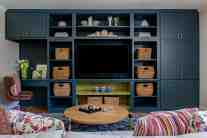
Proven Results On-Time and On-Budget
About Our Process
Imagine the moment you push open your front door...
Every detail of your living space is intentional, purposeful, and beautiful: The design of your office inspires productivity. The layout of your living room invites meaningful conversation. The colors of the kitchen encourage connected mealtimes.
Every detail, down to the vases on your bookshelf, makes you feel a certain way. Like the very best version of YOU.
Space this personalized requires a deep understanding of who you are, how you live, and what you’re drawn to.
Our detailed process makes it fun and easy for you to experience the joy and pride of a well-designed home - that happens both on time and on budget!
What It Looks Like
The team at ML Interiors Group uses a specialized four-phase process to naturally pull out these details of your life and translate them into beautiful and functional spaces in your home that match how you live, work, and play.
When it’s all done, you'll love coming home and think: “I didn’t know it was even possible to have a home that felt like this.”
This is what you can expect in each phase of the residential interior design process:
Research
We find out what makes you tick. We'll have in-depth conversations about what you really want, and then we'll dream big together!
Development
Elements of your dream design start coming together. We'll eliminate the confusion so you can easily visualize your interior design solution.
Procurement
We have long-standing partnerships with world-class vendors and craftspeople. We'll source every item, down to the last door pull, with meticulous detail.
Installation
Experience the relief and joy of watching your dream become reality as your design is put into place in the most effortless way.
Our In-Depth Interior Design Process
Research
Magazine-worthy homes all start with THIS first step…
A conversation about what you really want.
Instead of having an overwhelming number of choices, we want to make it easy to visualize everything you love together. Here’s how:
We’ll show you fabrics and photos of inspirational spaces. All you have to do is give us a “yes” or a “no” to tell us what you like or do not like about them. Together we will dream big about your well-designed home that expresses your personality, fits your lifestyle, and feels like your sanctuary. We also provide a practical solution (with a timeline and initial budget) that is congruent with your wishes. Through conversation and questionnaires, we’ll narrow down exactly how you want your home to look and feel.
Development
We believe that a home should tell a love story about the people who live there.
After listening carefully to your wants and needs, pulling out your preferences, and thoughtfully considering your lifestyle and personality, we’ll start sourcing (interior design lingo for shopping), and sourcing, and sourcing some more. Then we will turn your preferences into a design presentation.
This is the development phase, where we eliminate the confusion and make it easy to visualize your solution - turning your dream into a home you’re proud of.
Procurement
For interior home design to be successful, you need to know what you want. We guide you through this in the research and development phases, where we hone in on your personal style and then present the design of your space. But you also need to know where to get it. That brings us to the procurement phase, the third of our four-phase process.
Sit back and let us handle ALL of the details for you. That includes every little step like:
-
Creating a purchase order.
-
Confirming the vendor received the purchase order.
-
Following up to make sure the order is in process.
-
Tracking to delivery at the receiving warehouse.
-
Communicating with the vendor.
-
Handling any problems such as receiving a damaged, broken, back-ordered or (gasp!) wrong item
We handle everything behind the scenes—so you don’t have to! There's no stress of chasing down vendors, payments, and returns.
Installation
Imagine the moment you walk through the door of your “new” home and you can't stop smiling. We love giving our clients that hand-to-your-heart gasp - the moment when you feel the relief and joy of experiencing a newly designed home.
The home you once dreamed about comes to life in the final phase of our process: the installation. The installation of all of your hand-selected pieces can be either done in one day, or, depending on the size and scope of your project, it can be done in installments. Often clients give us a key, we let them know when we’ll be there, they notify the nanny, and we make it happen! Once all of the big pieces are in, we accessorize and ensure that the design is cohesive throughout the different rooms.
This isn’t just about furniture or design. This is about truly coming “home.”

Frequently Asked Questions
How do you structure your fees?
Our fee process is extremely transparent. During our free Design Discovery Call, we walk you through every detail, so don’t be shy to schedule one here. We charge a flat fee for design, so you know exactly what you’re paying us. We also take care of the procurement and installation, and those fees show up as separate line items on your invoice. We are happy to do your home in phases to compliment the pace at which you’re comfortable investing in your home.
Do you do renovations?
In short, yes! We love renovations. We have great referrals for contractors we know, like, and trust to implement your vision, and we collaborate with them to make sure your project is done on time and on budget. Importantly, we are not “married” to any one contractor. We have many great relationships, and we choose the contractor whose communication style, personality, and deliverables are best for you. We are also your advocate at every step of the process, so any contractor-related hassles will be fully taken care of by your team at MLIG.
What should my budget be?
Budget is very personal, and we have lots of options. Check out our friendly budget calculator to estimate an appropriate budget based on your desires and plans:
Living or Family Room
- Good: $115/sf
- Better: $155/sf
- Best: $195/sf
Dining Room
- Good: $100/sf
- Better: $115/sf
- Best: $130/sf
Home Office or Study
- Good: $70/sf
- Better: $100/sf
- Best: $130/sf
Main Bedroom
- Good: $90/sf
- Better: $130/sf
- Best: $170/sf
Contact us today to get an exact estimate for your space!
